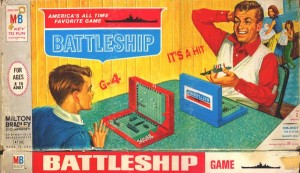Can You See Me Now?
by on 19th May 2015 in News

Dave Hendricks, LiveIntent president, reflects on the AOL/Verizon merger and predicts the rise of such deals will herald the end of probabilistic targeting.
If you are old enough, or an aficionado of board games, you might have heard of Battleship. This staple of childhood was an analog, old-fashioned game that didn’t involve consoles, required no electricity, and relied on person-to-person sonar.
Battleship was probabilistic. You would try to guess the coordinates and triangulate based on the shape of the ships. Once you figured out the coordinates, you would sink the battleship.
Back in the day, we were entertained by games that relied on guessing and extrapolation because, well, because that was all we had. As soon as Pong came around, it was bye-bye to Battleship! 
Pong was the first video game and it heralded a major change in gaming, resulting in crappy electronic versions of Battleship that no 10-year-old today would ever bother playing.
The last 15 years of ad technology were essentially one big game of Battleship – brands would use their third-party cookie assets, and using a probabilistic technology (aka ‘guessing’) vendor, the brand would attempt to ‘intercept’ consumers as they surfed the internet.
Today, marketing technology is slightly more advanced than Pong, but many marketers are still stuck in the past. They use technologies and approaches that are the marketing cloud equivalent of Battleship, even in this day and age. That is why Verizon’s acquisition of AOL is so interesting.
Verizon has long possessed the ability to see its customers. Verizon naturally has a device ID.
In addition, it also has personally identifiable information, or PII, billing data, postal addresses and, more often than not, an email address that matches all of the above.
Of course, Verizon is ‘mobile’ but it also has a ‘set-top box’, making its knowledge of audiences cross-device, deterministic, and persistent.
What Verizon was missing was owned content and ad technology, specifically the kind of emerging technology that is interesting to marketers: video ad technology; and purchase attribution capabilities. Plus, it found these key assets in what might have seemed to be an unlikely place: AOL.
Since Tim Armstrong joined AOL from Google in 2009, he has embarked on a controversial but ultimately successful approach. Working from a base of recurring revenues from the subscribers of AOL’s dial-up service (yes, people still pay AOL for their ISP), he methodically added next-generation publishing assets (he co-founded Patch, which was sold) and bought the immensely popular and successful Huffington Post.
With the legacy ISP subscriber money still rolling in, Tim added several key technology assets in Adapt.TV and Convertro. These last two purchases were the master keys that made the Verizon acquisition make total sense.
The merger of Verizon and AOL eliminates the game of Battleship. Verizon and AOL are now the marketing cloud technology version of Call of Duty Modern Warfare. This is because Verizon and AOL can now match Device ID, cookie, phone number, and email address.
True cross-screen advertising
‘Call of Duty: Marketing Warfare’ provides marketers with the ability to market (aka advertise) across Huffington Post, Adapt.TV videos to run on Verizon Handsets, and FiOS – Verizon's bundled internet access, telephone, and television service – to reach set-top boxes in the home.
Marketers utilising this stack should be able to set frequency control, test messages, and then perform attribution analysis to see market efficacy based on in-store purchase logs, online or offline.
Providing its marketer clients with logs of who has seen an ad is the ‘exposure file’ process. Verizon will be able to tell marketers who saw their ad, and who didn’t, securely and in a privacy-centric fashion.
This is very useful for yield and general ad optimisation. It leads to better publisher monetisation, and ultimately ads that are targeted based on first-party data should create higher consumer satisfaction and results, like any form of retargeting does today.
In a world where ad Blockers like ‘Shine’ are trying to disintermediate, Google, Facebook, and other publishers are creating new revenue streams for telecom networks via ad blocking agreements that pass extortion costs on to consumers. The Verizon/AOL merger looks like a move that might result in smarter – and unblocked – ads that consumers might actually act on.
 Verizon, I can hear you now. However, as we all know, hearing is not enough, you want to provide marketers with proof that their ads were seen by their customers.
Verizon, I can hear you now. However, as we all know, hearing is not enough, you want to provide marketers with proof that their ads were seen by their customers.
To those espousing probabilistic targeting, I think they have sunk your Battleship. Let’s play Pong.
Follow Dave Hendricks on Twitter on the handle: @davehendricks
Ad VerificationAdvertiserBrandingCross-ChannelDataDigital MarketingDisplayFacebookGoogleMedia SpendMobileNorth AmericaProgrammaticTargetingTVVideoViewability









Follow ExchangeWire